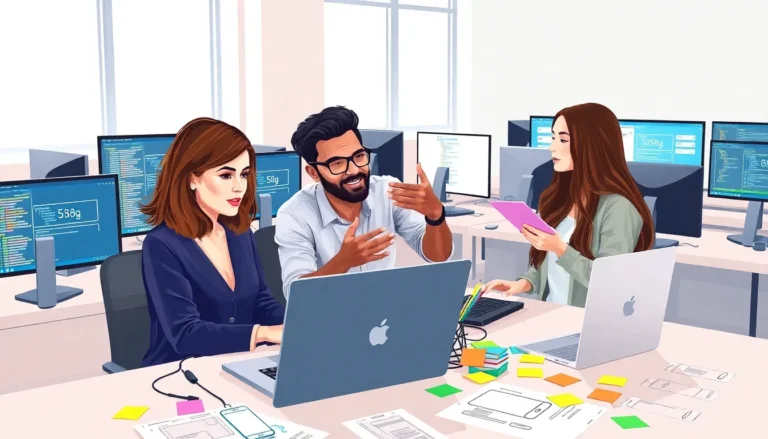Upgrading to a new iPhone is like unwrapping a shiny present, but transferring all those beloved apps can feel like a game of digital hide-and-seek. Who wants to spend hours downloading apps one by one when there’s a world of memes to scroll through? Fear not! With a few simple steps, you can seamlessly transfer all your apps and get back to binge-watching cat videos in no time.
Table of Contents
ToggleUnderstanding the Need to Transfer Apps
Upgrading to a new iPhone brings excitement, yet the task of transferring apps often poses a challenge. Users find the process daunting, especially when faced with the prospect of manually downloading each app again. Efficient app transfer simplifies the transition and ensures quick access to favorite activities, such as streaming videos or playing games.
Convenience serves as a primary reason for transferring apps. Reinstalling multiple apps takes time and effort. Users prefer to maintain their established routines without interruption. Prioritizing the transfer helps avoid frustrations and keeps the experience seamless.
Security also plays a vital role. App data often contains sensitive information, such as passwords and personal messages. Transferring apps securely ensures that this data remains protected during the switch. Utilizing built-in features, such as iCloud and iTunes, enhances the security of the transfer process.
Users gain peace of mind when they know their settings, preferences, and app data will transition smoothly. Familiar layouts and configurations mean less adaptation to a new device. Understanding the specific steps involved streamlines the entire relocation process.
Familiarity with the transfer methods ultimately enhances user satisfaction. Whether opting for direct transfer during setup or using backup methods, efficiency remains key. Utilizing the right tools ensures that the process occurs quickly, minimizing downtime and maximizing enjoyment of the new iPhone.
Preparing for the Transfer Process

Preparation simplifies the app transfer process and ensures a smooth transition. Prioritize these essential steps before moving to the new iPhone.
Backing Up Your Old iPhone
Backing up the old iPhone is crucial before starting the transfer. Users can utilize iCloud or iTunes for this process. iCloud allows automatic backups when connected to Wi-Fi while iTunes provides a manual way to save data locally. Both methods secure app data, ensuring it remains intact during the transfer. Check that enough storage is available on iCloud or external devices, as insufficient space can cause backup failures. To back up using iCloud, go to Settings, tap on your name, and select iCloud. For iTunes, connect the device to a computer, open iTunes, and click on the “Back Up Now” option.
Check for Software Updates
Checking for software updates ensures devices run on the latest system versions. The latest iOS version improves compatibility during the app transfer process. Users can check for updates by navigating to Settings, selecting General, and tapping Software Update. If a new version is available, downloading and installing it is essential. Running outdated software might cause issues that hinder app transfers. Keeping both devices updated enhances security and performance during the transition, providing a smoother user experience. Familiarize yourself with the update process to avoid unnecessary delays.
Methods to Transfer Apps
Transferring apps to a new iPhone can be straightforward with the right methods. Users can choose from several options to make the process efficient and hassle-free.
Using iCloud
iCloud enables seamless app transfer by backing up data from the old device. First, the user backs up the old iPhone via iCloud settings. After setting up the new device, selecting the “Restore from iCloud Backup” option brings all apps and app data to the new iPhone. Users should confirm that they’ve signed in with the same Apple ID on both devices. iCloud automatically reinstalls compatible apps, preserving essential data and preferences during the transition.
Using iTunes
Using iTunes provides another reliable way to transfer apps quickly. The user connects the old iPhone to a computer, launches iTunes, and selects the device icon. After initiating a backup, they can disconnect the old iPhone and plug in the new one. Selecting “Restore Backup” transfers all apps and app data. Ensuring both devices are running the latest software version helps avoid compatibility issues during this process.
Direct Transfer via Quick Start
Quick Start allows instant app transfer when setting up the new iPhone. Users place both devices close together, ensuring Bluetooth is enabled. Following the on-screen instructions sets up the new iPhone, with the option to transfer data from the old iPhone. This method transfers apps, settings, and other data, making it an efficient choice for users looking to upgrade quickly. Both devices need to run on iOS 11 or later for this process to work effectively.
Troubleshooting Common Issues
Transferring apps to a new iPhone can sometimes lead to issues. Understanding common problems can help users navigate challenges smoothly.
App Compatibility Concerns
App compatibility might create hurdles during the transfer process. Older apps may not operate on the latest iOS or may require updates. Checking for app updates on the old device improves compatibility. Users can verify app availability on the App Store of the new iPhone as well. Some apps, specifically those tailored for older systems, might not have successors available. Users needing critical apps must ensure their latest versions are compatible before the transfer.
Insufficient Storage Space
Storage issues can complicate the app transfer. New iPhones typically come with various storage options; users should evaluate their available space. Users experiencing insufficient storage might decide to remove less important apps or data to free up space. Transferring only essential apps streamlines the process and allows smoother setup. Checking storage on the new device before starting the transfer confirms adequate space for app installations. If challenges persist, consider using cloud storage solutions temporarily for excess files.
Transferring apps to a new iPhone doesn’t have to be a daunting task. By leveraging built-in features like iCloud, iTunes, and Quick Start, users can ensure a seamless transition. This process not only saves time but also maintains the familiarity of their favorite apps and settings.
With careful preparation and attention to potential issues, users can enjoy their new device without interruption. Embracing these methods allows for a hassle-free experience, letting them dive right back into their daily routines. The excitement of a new iPhone can be fully realized when the transition is smooth and efficient.



